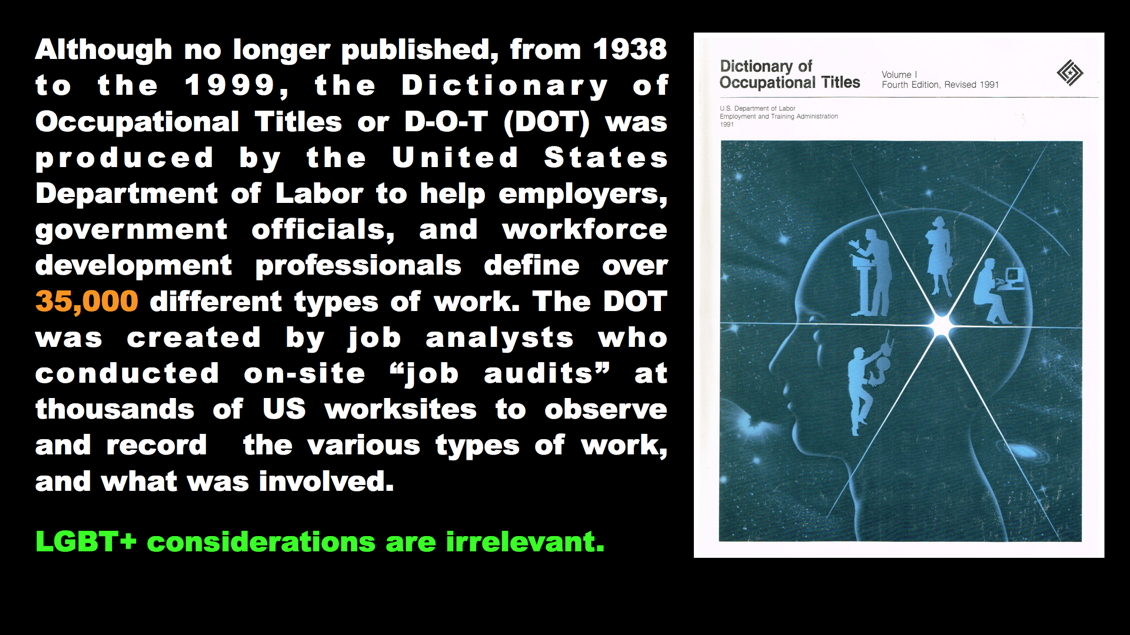The "Big Picture" of the "Woke" Agenda
The "FUTURE" EEO-1 (private sector) and EEO-4 (public sector)
| JOB CATEGORY EXECUTIVE/ SENIOR LEVEL OFFICIALS & MANAGERS |
MEN | WOMEN | ||||||||||
| White | Black | Latina | Native American |
Asian | 2 or More |
White | Black | Latina | Native American |
Asian | 2 or More |
|
Agender |
||||||||||||
Androgynous |
||||||||||||
Asexual |
||||||||||||
Bestiality |
||||||||||||
Bigamists |
||||||||||||
Bisexual |
||||||||||||
Demiromantic |
||||||||||||
Demisexual |
||||||||||||
Feminine-of-Center |
||||||||||||
Feminine-presenting |
||||||||||||
Gay |
||||||||||||
Gender non-conforming |
||||||||||||
Gender-expansive |
||||||||||||
Gender-fluid |
||||||||||||
Genderqueer |
||||||||||||
Incest-based |
||||||||||||
Intergender |
||||||||||||
Intersex |
||||||||||||
Lesbian |
||||||||||||
Man/Male |
||||||||||||
Masculine-of-Center |
||||||||||||
Masculine-presenting |
||||||||||||
Neutrois |
||||||||||||
Non-binary |
||||||||||||
Pangender |
||||||||||||
Pansexual |
||||||||||||
Pedophiles |
||||||||||||
Polygamists |
||||||||||||
Polygender |
||||||||||||
Queer (Sexual Orientation) |
||||||||||||
Queer (Gender Identity) |
||||||||||||
Questioning (Sexual Orientation) |
||||||||||||
Questioning (Gender Identity) |
||||||||||||
Same-gender-loving |
||||||||||||
Sexual Masochists |
||||||||||||
Skoliosexual |
||||||||||||
Straight or Heterosexual |
||||||||||||
Transfeminine |
||||||||||||
Transgender |
||||||||||||
Transgender man/male |
||||||||||||
Transgender woman/female |
||||||||||||
Transmasculine |
||||||||||||
Two-spirit |
||||||||||||
Woman/Female |
||||||||||||
Zoophiles |
||||||||||||
ADA (Mental Disability) |
||||||||||||
ADA (Physical Disability) |
||||||||||||
RELIGION (Christian) |
||||||||||||
RELIGION (Muslim) |
||||||||||||
RELIGION (Jew) |
||||||||||||
Pregnant |
||||||||||||
| JOB CATEGORY FIRST / MID OFFICIALS & MANAGERS |
MEN | WOMEN | ||||||||||
| White | Black | Latina | Native American |
Asian | 2 or More |
White | Black | Latina | Native American |
Asian | 2 or More |
|
Agender |
||||||||||||
Androgynous |
||||||||||||
Asexual |
||||||||||||
Bestiality |
||||||||||||
Bigamists |
||||||||||||
Bisexual |
||||||||||||
Demiromantic |
||||||||||||
Demisexual |
||||||||||||
Feminine-of-Center |
||||||||||||
Feminine-presenting |
||||||||||||
Gay |
||||||||||||
Gender non-conforming |
||||||||||||
Gender-expansive |
||||||||||||
Gender-fluid |
||||||||||||
Genderqueer |
||||||||||||
Incest-based |
||||||||||||
Intergender |
||||||||||||
Intersex |
||||||||||||
Lesbian |
||||||||||||
Man/Male |
||||||||||||
Masculine-of-Center |
||||||||||||
Masculine-presenting |
||||||||||||
Neutrois |
||||||||||||
Non-binary |
||||||||||||
Pangender |
||||||||||||
Pansexual |
||||||||||||
Pedophiles |
||||||||||||
Polygamists |
||||||||||||
Polygender |
||||||||||||
Queer (Sexual Orientation) |
||||||||||||
Queer (Gender Identity) |
||||||||||||
Questioning (Sexual Orientation) |
||||||||||||
Questioning (Gender Identity) |
||||||||||||
Same-gender-loving |
||||||||||||
Sexual Masochists |
||||||||||||
Skoliosexual |
||||||||||||
Straight or Heterosexual |
||||||||||||
Transfeminine |
||||||||||||
Transgender |
||||||||||||
Transgender man/male |
||||||||||||
Transgender woman/female |
||||||||||||
Transmasculine |
||||||||||||
Two-spirit |
||||||||||||
Woman/Female |
||||||||||||
Zoophiles |
||||||||||||
ADA (Mental Disability) |
||||||||||||
ADA (Physical Disability) |
||||||||||||
RELIGION (Christian) |
||||||||||||
RELIGION (Muslim) |
||||||||||||
RELIGION (Jew) |
||||||||||||
Pregnant |
||||||||||||
| JOB CATEGORY PROFESSIONALS |
MEN | WOMEN | ||||||||||
| White | Black | Latina | Native American |
Asian | 2 or More |
White | Black | Latina | Native American |
Asian | 2 or More |
|
Agender |
||||||||||||
Androgynous |
||||||||||||
Asexual |
||||||||||||
Bestiality |
||||||||||||
Bigamists |
||||||||||||
Bisexual |
||||||||||||
Demiromantic |
||||||||||||
Demisexual |
||||||||||||
Feminine-of-Center |
||||||||||||
Feminine-presenting |
||||||||||||
Gay |
||||||||||||
Gender non-conforming |
||||||||||||
Gender-expansive |
||||||||||||
Gender-fluid |
||||||||||||
Genderqueer |
||||||||||||
Incest-based |
||||||||||||
Intergender |
||||||||||||
Intersex |
||||||||||||
Lesbian |
||||||||||||
Man/Male |
||||||||||||
Masculine-of-Center |
||||||||||||
Masculine-presenting |
||||||||||||
Neutrois |
||||||||||||
Non-binary |
||||||||||||
Pangender |
||||||||||||
Pansexual |
||||||||||||
Pedophiles |
||||||||||||
Polygamists |
||||||||||||
Polygender |
||||||||||||
Queer (Sexual Orientation) |
||||||||||||
Queer (Gender Identity) |
||||||||||||
Questioning (Sexual Orientation) |
||||||||||||
Questioning (Gender Identity) |
||||||||||||
Same-gender-loving |
||||||||||||
Sexual Masochists |
||||||||||||
Skoliosexual |
||||||||||||
Straight or Heterosexual |
||||||||||||
Transfeminine |
||||||||||||
Transgender |
||||||||||||
Transgender man/male |
||||||||||||
Transgender woman/female |
||||||||||||
Transmasculine |
||||||||||||
Two-spirit |
||||||||||||
Woman/Female |
||||||||||||
Zoophiles |
||||||||||||
ADA (Mental Disability) |
||||||||||||
ADA (Physical Disability) |
||||||||||||
RELIGION (Christian) |
||||||||||||
RELIGION (Muslim) |
||||||||||||
RELIGION (Jew) |
||||||||||||
Pregnant |
||||||||||||
| JOB CATEGORY TECHNICIANS |
MEN | WOMEN | ||||||||||
| White | Black | Latina | Native American |
Asian | 2 or More |
White | Black | Latina | Native American |
Asian | 2 or More |
|
Agender |
||||||||||||
Androgynous |
||||||||||||
Asexual |
||||||||||||
Bestiality |
||||||||||||
Bigamists |
||||||||||||
Bisexual |
||||||||||||
Demiromantic |
||||||||||||
Demisexual |
||||||||||||
Feminine-of-Center |
||||||||||||
Feminine-presenting |
||||||||||||
Gay |
||||||||||||
Gender non-conforming |
||||||||||||
Gender-expansive |
||||||||||||
Gender-fluid |
||||||||||||
Genderqueer |
||||||||||||
Incest-based |
||||||||||||
Intergender |
||||||||||||
Intersex |
||||||||||||
Lesbian |
||||||||||||
Man/Male |
||||||||||||
Masculine-of-Center |
||||||||||||
Masculine-presenting |
||||||||||||
Neutrois |
||||||||||||
Non-binary |
||||||||||||
Pangender |
||||||||||||
Pansexual |
||||||||||||
Pedophiles |
||||||||||||
Polygamists |
||||||||||||
Polygender |
||||||||||||
Queer (Sexual Orientation) |
||||||||||||
Queer (Gender Identity) |
||||||||||||
Questioning (Sexual Orientation) |
||||||||||||
Questioning (Gender Identity) |
||||||||||||
Same-gender-loving |
||||||||||||
Sexual Masochists |
||||||||||||
Skoliosexual |
||||||||||||
Straight or Heterosexual |
||||||||||||
Transfeminine |
||||||||||||
Transgender |
||||||||||||
Transgender man/male |
||||||||||||
Transgender woman/female |
||||||||||||
Transmasculine |
||||||||||||
Two-spirit |
||||||||||||
Woman/Female |
||||||||||||
Zoophiles |
||||||||||||
ADA (Mental Disability) |
||||||||||||
ADA (Physical Disability) |
||||||||||||
RELIGION (Christian) |
||||||||||||
RELIGION (Muslim) |
||||||||||||
RELIGION (Jew) |
||||||||||||
Pregnant |
||||||||||||
| JOB CATEGORY SALES WORKERS |
MEN | WOMEN | ||||||||||
| White | Black | Latina | Native American |
Asian | 2 or More |
White | Black | Latina | Native American |
Asian | 2 or More |
|
Agender |
||||||||||||
Androgynous |
||||||||||||
Asexual |
||||||||||||
Bestiality |
||||||||||||
Bigamists |
||||||||||||
Bisexual |
||||||||||||
Demiromantic |
||||||||||||
Demisexual |
||||||||||||
Feminine-of-Center |
||||||||||||
Feminine-presenting |
||||||||||||
Gay |
||||||||||||
Gender non-conforming |
||||||||||||
Gender-expansive |
||||||||||||
Gender-fluid |
||||||||||||
Genderqueer |
||||||||||||
Incest-based |
||||||||||||
Intergender |
||||||||||||
Intersex |
||||||||||||
Lesbian |
||||||||||||
Man/Male |
||||||||||||
Masculine-of-Center |
||||||||||||
Masculine-presenting |
||||||||||||
Neutrois |
||||||||||||
Non-binary |
||||||||||||
Pangender |
||||||||||||
Pansexual |
||||||||||||
Pedophiles |
||||||||||||
Polygamists |
||||||||||||
Polygender |
||||||||||||
Queer (Sexual Orientation) |
||||||||||||
Queer (Gender Identity) |
||||||||||||
Questioning (Sexual Orientation) |
||||||||||||
Questioning (Gender Identity) |
||||||||||||
Same-gender-loving |
||||||||||||
Sexual Masochists |
||||||||||||
Skoliosexual |
||||||||||||
Straight or Heterosexual |
||||||||||||
Transfeminine |
||||||||||||
Transgender |
||||||||||||
Transgender man/male |
||||||||||||
Transgender woman/female |
||||||||||||
Transmasculine |
||||||||||||
Two-spirit |
||||||||||||
Woman/Female |
||||||||||||
Zoophiles |
||||||||||||
ADA (Mental Disability) |
||||||||||||
ADA (Physical Disability) |
||||||||||||
RELIGION (Christian) |
||||||||||||
RELIGION (Muslim) |
||||||||||||
RELIGION (Jew) |
||||||||||||
Pregnant |
||||||||||||
| JOB CATEGORY ADMINISTRATIVE SUPPORT |
MEN | WOMEN | ||||||||||
| White | Black | Latina | Native American |
Asian | 2 or More |
White | Black | Latina | Native American |
Asian | 2 or More |
|
Agender |
||||||||||||
Androgynous |
||||||||||||
Asexual |
||||||||||||
Bestiality |
||||||||||||
Bigamists |
||||||||||||
Bisexual |
||||||||||||
Demiromantic |
||||||||||||
Demisexual |
||||||||||||
Feminine-of-Center |
||||||||||||
Feminine-presenting |
||||||||||||
Gay |
||||||||||||
Gender non-conforming |
||||||||||||
Gender-expansive |
||||||||||||
Gender-fluid |
||||||||||||
Genderqueer |
||||||||||||
Incest-based |
||||||||||||
Intergender |
||||||||||||
Intersex |
||||||||||||
Lesbian |
||||||||||||
Man/Male |
||||||||||||
Masculine-of-Center |
||||||||||||
Masculine-presenting |
||||||||||||
Neutrois |
||||||||||||
Non-binary |
||||||||||||
Pangender |
||||||||||||
Pansexual |
||||||||||||
Pedophiles |
||||||||||||
Polygamists |
||||||||||||
Polygender |
||||||||||||
Queer (Sexual Orientation) |
||||||||||||
Queer (Gender Identity) |
||||||||||||
Questioning (Sexual Orientation) |
||||||||||||
Questioning (Gender Identity) |
||||||||||||
Same-gender-loving |
||||||||||||
Sexual Masochists |
||||||||||||
Skoliosexual |
||||||||||||
Straight or Heterosexual |
||||||||||||
Transfeminine |
||||||||||||
Transgender |
||||||||||||
Transgender man/male |
||||||||||||
Transgender woman/female |
||||||||||||
Transmasculine |
||||||||||||
Two-spirit |
||||||||||||
Woman/Female |
||||||||||||
Zoophiles |
||||||||||||
ADA (Mental Disability) |
||||||||||||
ADA (Physical Disability) |
||||||||||||
RELIGION (Christian) |
||||||||||||
RELIGION (Muslim) |
||||||||||||
RELIGION (Jew) |
||||||||||||
Pregnant |
||||||||||||
| JOB CATEGORY CRAFT WORKERS |
MEN | WOMEN | ||||||||||
| White | Black | Latina | Native American |
Asian | 2 or More |
White | Black | Latina | Native American |
Asian | 2 or More |
|
Agender |
||||||||||||
Androgynous |
||||||||||||
Asexual |
||||||||||||
Bestiality |
||||||||||||
Bigamists |
||||||||||||
Bisexual |
||||||||||||
Demiromantic |
||||||||||||
Demisexual |
||||||||||||
Feminine-of-Center |
||||||||||||
Feminine-presenting |
||||||||||||
Gay |
||||||||||||
Gender non-conforming |
||||||||||||
Gender-expansive |
||||||||||||
Gender-fluid |
||||||||||||
Genderqueer |
||||||||||||
Incest-based |
||||||||||||
Intergender |
||||||||||||
Intersex |
||||||||||||
Lesbian |
||||||||||||
Man/Male |
||||||||||||
Masculine-of-Center |
||||||||||||
Masculine-presenting |
||||||||||||
Neutrois |
||||||||||||
Non-binary |
||||||||||||
Pangender |
||||||||||||
Pansexual |
||||||||||||
Pedophiles |
||||||||||||
Polygamists |
||||||||||||
Polygender |
||||||||||||
Queer (Sexual Orientation) |
||||||||||||
Queer (Gender Identity) |
||||||||||||
Questioning (Sexual Orientation) |
||||||||||||
Questioning (Gender Identity) |
||||||||||||
Same-gender-loving |
||||||||||||
Sexual Masochists |
||||||||||||
Skoliosexual |
||||||||||||
Straight or Heterosexual |
||||||||||||
Transfeminine |
||||||||||||
Transgender |
||||||||||||
Transgender man/male |
||||||||||||
Transgender woman/female |
||||||||||||
Transmasculine |
||||||||||||
Two-spirit |
||||||||||||
Woman/Female |
||||||||||||
Zoophiles |
||||||||||||
ADA (Mental Disability) |
||||||||||||
ADA (Physical Disability) |
||||||||||||
RELIGION (Christian) |
||||||||||||
RELIGION (Muslim) |
||||||||||||
RELIGION (Jew) |
||||||||||||
Pregnant |
||||||||||||
| JOB CATEGORY OPERATIVES |
MEN | WOMEN | ||||||||||
| White | Black | Latina | Native American |
Asian | 2 or More |
White | Black | Latina | Native American |
Asian | 2 or More |
|
Agender |
||||||||||||
Androgynous |
||||||||||||
Asexual |
||||||||||||
Bestiality |
||||||||||||
Bigamists |
||||||||||||
Bisexual |
||||||||||||
Demiromantic |
||||||||||||
Demisexual |
||||||||||||
Feminine-of-Center |
||||||||||||
Feminine-presenting |
||||||||||||
Gay |
||||||||||||
Gender non-conforming |
||||||||||||
Gender-expansive |
||||||||||||
Gender-fluid |
||||||||||||
Genderqueer |
||||||||||||
Incest-based |
||||||||||||
Intergender |
||||||||||||
Intersex |
||||||||||||
Lesbian |
||||||||||||
Man/Male |
||||||||||||
Masculine-of-Center |
||||||||||||
Masculine-presenting |
||||||||||||
Neutrois |
||||||||||||
Non-binary |
||||||||||||
Pangender |
||||||||||||
Pansexual |
||||||||||||
Pedophiles |
||||||||||||
Polygamists |
||||||||||||
Polygender |
||||||||||||
Queer (Sexual Orientation) |
||||||||||||
Queer (Gender Identity) |
||||||||||||
Questioning (Sexual Orientation) |
||||||||||||
Questioning (Gender Identity) |
||||||||||||
Same-gender-loving |
||||||||||||
Sexual Masochists |
||||||||||||
Skoliosexual |
||||||||||||
Straight or Heterosexual |
||||||||||||
Transfeminine |
||||||||||||
Transgender |
||||||||||||
Transgender man/male |
||||||||||||
Transgender woman/female |
||||||||||||
Transmasculine |
||||||||||||
Two-spirit |
||||||||||||
Woman/Female |
||||||||||||
Zoophiles |
||||||||||||
ADA (Mental Disability) |
||||||||||||
ADA (Physical Disability) |
||||||||||||
RELIGION (Christian) |
||||||||||||
RELIGION (Muslim) |
||||||||||||
RELIGION (Jew) |
||||||||||||
Pregnant |
||||||||||||
| JOB CATEGORY LABORERS & HELPERS |
MEN | WOMEN | ||||||||||
| White | Black | Latina | Native American |
Asian | 2 or More |
White | Black | Latina | Native American |
Asian | 2 or More |
|
Agender |
||||||||||||
Androgynous |
||||||||||||
Asexual |
||||||||||||
Bestiality |
||||||||||||
Bigamists |
||||||||||||
Bisexual |
||||||||||||
Demiromantic |
||||||||||||
Demisexual |
||||||||||||
Feminine-of-Center |
||||||||||||
Feminine-presenting |
||||||||||||
Gay |
||||||||||||
Gender non-conforming |
||||||||||||
Gender-expansive |
||||||||||||
Gender-fluid |
||||||||||||
Genderqueer |
||||||||||||
Incest-based |
||||||||||||
Intergender |
||||||||||||
Intersex |
||||||||||||
Lesbian |
||||||||||||
Man/Male |
||||||||||||
Masculine-of-Center |
||||||||||||
Masculine-presenting |
||||||||||||
Neutrois |
||||||||||||
Non-binary |
||||||||||||
Pangender |
||||||||||||
Pansexual |
||||||||||||
Pedophiles |
||||||||||||
Polygamists |
||||||||||||
Polygender |
||||||||||||
Queer (Sexual Orientation) |
||||||||||||
Queer (Gender Identity) |
||||||||||||
Questioning (Sexual Orientation) |
||||||||||||
Questioning (Gender Identity) |
||||||||||||
Same-gender-loving |
||||||||||||
Sexual Masochists |
||||||||||||
Skoliosexual |
||||||||||||
Straight or Heterosexual |
||||||||||||
Transfeminine |
||||||||||||
Transgender |
||||||||||||
Transgender man/male |
||||||||||||
Transgender woman/female |
||||||||||||
Transmasculine |
||||||||||||
Two-spirit |
||||||||||||
Woman/Female |
||||||||||||
Zoophiles |
||||||||||||
ADA (Mental Disability) |
||||||||||||
ADA (Physical Disability) |
||||||||||||
RELIGION (Christian) |
||||||||||||
RELIGION (Muslim) |
||||||||||||
RELIGION (Jew) |
||||||||||||
Pregnant |
||||||||||||
| JOB CATEGORY SERVICE WORKERS |
MEN | WOMEN | ||||||||||
| White | Black | Latina | Native American |
Asian | 2 or More |
White | Black | Latina | Native American |
Asian | 2 or More |
|
Agender |
||||||||||||
Androgynous |
||||||||||||
Asexual |
||||||||||||
Bestiality |
||||||||||||
Bigamists |
||||||||||||
Bisexual |
||||||||||||
Demiromantic |
||||||||||||
Demisexual |
||||||||||||
Feminine-of-Center |
||||||||||||
Feminine-presenting |
||||||||||||
Gay |
||||||||||||
Gender non-conforming |
||||||||||||
Gender-expansive |
||||||||||||
Gender-fluid |
||||||||||||
Genderqueer |
||||||||||||
Incest-based |
||||||||||||
Intergender |
||||||||||||
Intersex |
||||||||||||
Lesbian |
||||||||||||
Man/Male |
||||||||||||
Masculine-of-Center |
||||||||||||
Masculine-presenting |
||||||||||||
Neutrois |
||||||||||||
Non-binary |
||||||||||||
Pangender |
||||||||||||
Pansexual |
||||||||||||
Pedophiles |
||||||||||||
Polygamists |
||||||||||||
Polygender |
||||||||||||
Queer (Sexual Orientation) |
||||||||||||
Queer (Gender Identity) |
||||||||||||
Questioning (Sexual Orientation) |
||||||||||||
Questioning (Gender Identity) |
||||||||||||
Same-gender-loving |
||||||||||||
Sexual Masochists |
||||||||||||
Skoliosexual |
||||||||||||
Straight or Heterosexual |
||||||||||||
Transfeminine |
||||||||||||
Transgender |
||||||||||||
Transgender man/male |
||||||||||||
Transgender woman/female |
||||||||||||
Transmasculine |
||||||||||||
Two-spirit |
||||||||||||
Woman/Female |
||||||||||||
Zoophiles |
||||||||||||
ADA (Mental Disability) |
||||||||||||
ADA (Physical Disability) |
||||||||||||
RELIGION (Christian) |
||||||||||||
RELIGION (Muslim) |
||||||||||||
RELIGION (Jew) |
||||||||||||
Pregnant |
||||||||||||
OBSERVATION: If you find the above exhibit distrubing, perhaps YOU should tell employers to stop playing the "race card, sex card, LGBT+ card, etc.," and instead, use the Uniform Guidelines on Employee Selection; and then make hiring decisions after actually validating which candidate demonstrates the highest proficiency performing the posted essential job functions.
The Uniform Guidelines on Employee Selection (criterion-related, content, and construct validity).>> Evidence of the validity of a test or other selection procedure by a criterion-related validity assessment should consist of empirical data demonstrating that the selection procedure is predictive of or significantly correlated with important elements of job performance.
>> Evidence of the validity of a test or other selection procedure by a content validity assessment should consist of data showing that the content of the selection procedure is representative of important aspects of performance on the job for which the candidates are to be evaluated.
>> Evidence of the validity of a test or other selection procedure through a construct validity assessment should consist of data showing that the procedure measures the degree to which candidates have identifiable characteristics which have been determined to be important in successful performance in the job for which the candidates are to be evaluated.
Unlike the Uniform Guidelines on Employee Selection, which is specific to and validates (proves) the candidate can perform the actual work as defined by the posted essential job functions and corresponding job standards, behavior-based "evaluations" are overtly subjective, and do not assess or validagte if the candidate can perform the actual work as defined by the posted essential ljob functions and corresponding job standards.PRIVATE SECTOR - In the private for-profit sector, the primary “focus” or objective of the employer is to generate revenue and produce a profit. “Cultural, civic, and social considerations” are subordinate to the employer’s “business culture,” which is designed to achieve strategic business unit objectives to sustain the business. The aforementioned does not mean an employer intentionally violates employment laws (Title VII, FLSA, ADEA, etc.) in order to achieve profit; but simply put, in the absence of profit the company will eventually cease to exist (Braniff Airlines, Oldsmobile, Montgomery Ward, American Motors, etc.). However, in the event of claims of discrimination, which prompt civil litigation and criminal investigation (EEOC, Department of Justice, OFCCP, etc.), the “culture” of for-profit companies is often reflected by its EEO-1 reporting, ERISA, Vets-100, OFCCP or other measures.
PUBLIC SECTOR - In the public non-profit sector, the primary “focus” or objective of the employer is to generate revenue for the delivery of public services or production of non-commercial products. Given that public funding and/or tax dollars are often used to facilitate the delivery of services, a much more diverse “business culture” is typically required to ensure an equitable representation of diversely demographic populations. Such “cultural” diversity is validated by EEO-4 reporting, ERISA, Vets-100, OFCCP, and other measures.
Keep in mind, the "relationship" between the employer and employee is not behavior-based, but performance-based; it's an adult-to-adult relationship, not parent to child.
"Employment" is a professional relationship, where professional work-related standards of courtesy, congeniality, diplomacy, and as required, an employment contract includes a "morals clause" as an inherent performance-based job standard, and bereft of any "emotionalism."
Employers do not monitor or measure what an employee does with her biological or manufactured vagina or his biological or manufactured penis, because as captured by EEO-1s and EEO-4s (above) and the Dictionary of Occupational Titles (below), except for the adult pornography industry, the character and scope of work does not require an employee to use her biological or manufactured vagina or his biological or manufactured penis in order to perform the essential job functions.
In a work environment, employers do not monitor how employees behave, as if they're children. For example, when a minor child throws a tantrum and physically hits another, the child is admonished, possibly suspended. Conversely, an adult who physically hits another adult has committed an assault and is subject to immediate termination for violation of company policy, and subject to civil litigation and criminal prosecution. Employers, unlike parents, do not to coddle children, or advocate or support an employee as a "friend." Clearly, as established by the "at will" doctrine, the employer can terminate an employee at any time, with or without notice; and an employee can terminate at any time, with or without notice.
I welcome your feedback.Trip Reynolds
trip.reynolds@yahoo.com
Reynolds' Rap
December 13, 2023
© 2017-2023 Tripoetry. All Rights Reserved.
First Amendment to the United States Constitution - Congress shall make no law respecting an establishment of religion, or prohibiting the free exercise thereof; or abridging the freedom of speech, or of the press; or the right of the people peaceably to assemble, and to petition the Government for a redress of grievances.



